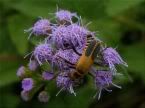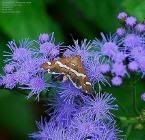

Scientific Name
Conoclinium coelestinum
Uses of Blue Mistflower: Landscaping, Medicinal, Culinary, etc...
This plant is used mainly for landscape beautification. It has potential for use in cultivated, garden situations, in naturalized prairie or meadow plantings, and along roadsides.
General Characteristics
Sunflower Family (Asteraceae). Mistflower is an erect (to 3 feet), rhizomatous perennial, often forming colonies. It is a U.S. native. The opposite leaves are oval-shaped, hairy, and have toothed edges. The small flower heads are clustered at the top of the plant. They are powder blue to violet and fluffy in appearance, similar to Ageratums used as garden bedding plants. The tiny seeds are black, elongated, and have long white hairs attached to one end
Required Growing Conditions
Mistflower is adapted to most soil types, but is especially suited to heavy textured and to highly organic soils. Natural stands are found on moist to wet sites, such as low woods, wet meadows, and ditches. It grows best in full sun, but will tolerate light shade.
Blue mistflower is distributed throughout the eastern and midwest United States.
Cultivation and Care
A clean, firm seedbed is essential. The site should be treated with a herbicide to control existing vegetation, tilled, cultipacked once or twice, and allowed to settle thoroughly before sowing. Broadcast ½ to ¾ gram seed per 100 square feet (½ to ¾ lb/acre). Bulk sowing rates usually need to be increased to allow for low purity values. The seed can be mixed with sand or rice hulls to increase volume so that it will be easier to spread uniformly over the planting site. Seed must remain on the soil surface because they are easily smothered when buried in the soil. The seed will not germinate until the following spring, but will benefit from the cool, moist winter environment.
General Upkeep and Control
Apply fertilizer according to soil test recommendations. If not available, a rate of 3½ to 5½ oz/100 square feet (100 to 150 lbs/acre) of 13-13-13 should be applied after the seedlings are established and annually thereafter. Stands can be mowed in the spring and early summer. Later mowings should be delayed until the plants have set seed.
Control Please contact your local agricultural extension specialist or county weed specialist to learn what works best in your area and how to use it safely. Always read label and safety instructions for each control method. Trade names and control measures appear in this document only to provide specific information. USDA, NRCS does not guarantee or warranty the products and control methods named, and other products may be equally effective.





0 comments: